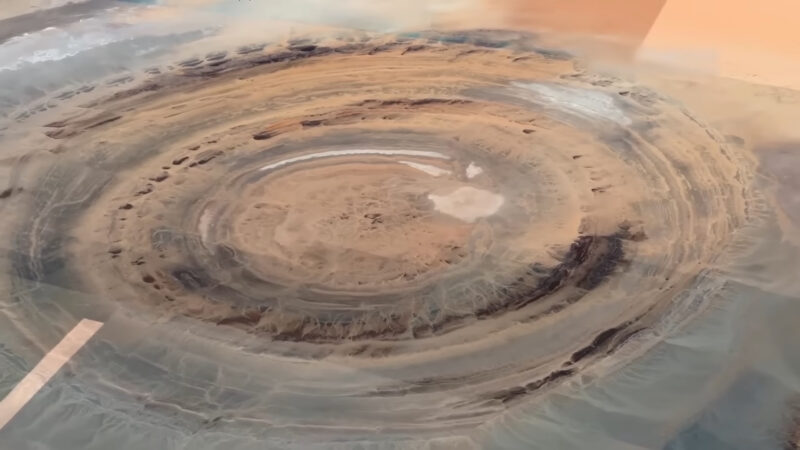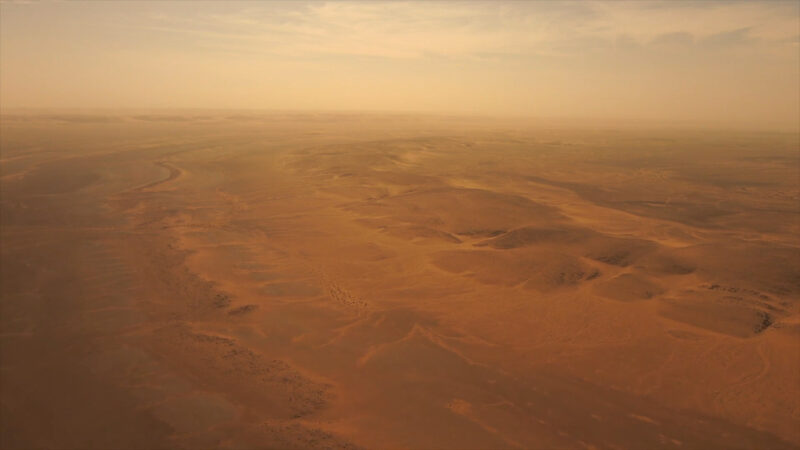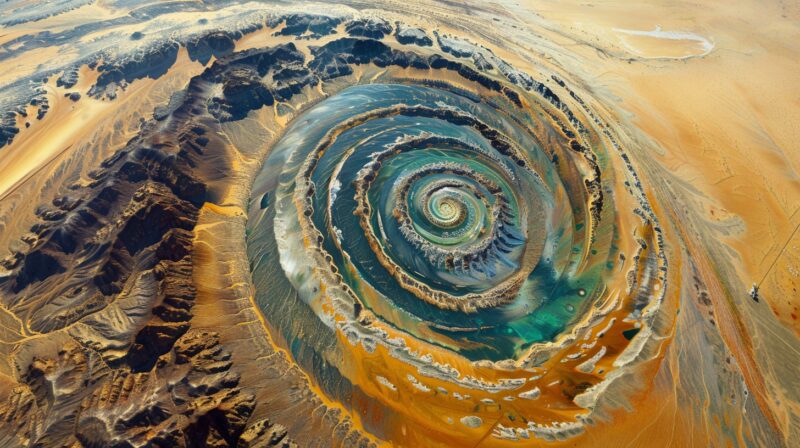The Eye of the Sahara, also known as the Richat Structure, is a striking geological formation located in the Sahara Desert in Mauritania. This massive, circular feature is approximately 50 kilometers in diameter and can be easily seen from space, resembling a giant eye. Known for its concentric rings of rock, this geological wonder has puzzled scientists and inspired myths for years.
The Richat Structure not only offers a spectacular view from above but also provides invaluable insights into the Earth’s geological past. Its distinct appearance and mysterious origin make it a subject of fascination for both scientists and the general public.
Table of Contents
ToggleOrigin of the Name

The structure’s eye-like appearance is so perfect that it has led to various nicknames, including the “Blue Eye of Africa” and “Sahara’s Eye.”
The name “Richat” comes from the local Berber word for “feather,” which describes its intricate, feather-like patterns. When viewed from space, this formation resembles a massive eye looking up from the desert, leading to the nickname “Eye of the Sahara.”
This great feature’s appearance is enhanced by its concentric circles, giving it a distinct, eye-like pattern. The vivid visual similarity to an eye makes it one of the most recognizable landmarks on our planet. Despite its remote location, the Richat Structure has captured the imagination of many who wonder about its origins and significance.
The Eye of the Sahara is so large and distinct that it can be seen from space. Astronauts aboard the International Space Station often use it as a landmark to navigate.
Geological Formation
Contrary to popular belief, the Eye of the Sahara is not an impact crater. It is actually a deeply eroded geological dome.
The formation of the Richat Structure is a topic of ongoing scientific debate. The most widely accepted theory is that it is an eroded geological dome. This dome was likely formed by volcanic activity that uplifted the land millions of years ago. Over time, erosion wore away the softer rock layers, leaving behind the harder, more resistant layers in concentric circles.
These layers include sandstone, limestone, and volcanic rock, which erode at different rates, contributing to the structure’s unique appearance. The circular rings we see today are a testament to the powerful geological processes that have shaped our planet over eons.
Some scientists believe that the Richat Structure might have formed due to a volcanic explosion or the collapse of a magma chamber, though these theories are less widely accepted.
What is clear is that this formation provides a unique window into the geological history of the region, revealing layers of rock that span hundreds of millions of years. This cross-section of the Earth’s crust offers valuable insights into the processes that have shaped our planet.
The concentric rings of the Eye of the Sahara provide a natural cross-section of the Earth’s crust, showcasing millions of years of geological history in one place.
Misconceptions and Theories
The Richat Structure has inspired myths and legends, including speculations that it could be the site of the lost city of Atlantis.
The Eye of the Sahara has inspired numerous myths and theories. One of the most popular, yet unfounded, is that it is the remnants of the lost city of Atlantis. This theory gained traction due to the structure’s distinctive shape and its location in the Sahara Desert, which some believe could match the descriptions of Atlantis.
However, there is no scientific evidence to support this claim, and it remains a topic of speculation rather than fact.
Another misconception is that the Richat Structure was created by a meteor impact. While it does resemble an impact crater, there is no evidence of shocked quartz or other indicators that would suggest such an origin.
The formation’s shape and structure are more consistent with an eroded geological dome rather than an impact site. These misconceptions, though intriguing, often overshadow the scientific value of the Richat Structure as a natural geological formation.
Cool for scientists
This big eye shape in the desert is really cool for scientists to study! Because the different colored ring layers are exposed above ground, scientists can learn a lot about what the Earth was like long ago. Usually, you can’t see through the ground, but here it’s like the Earth cut itself open so we could peek inside!
The rings are made of different types of rock that formed at different times. By looking closely at each one, scientists can figure out things like what the climate was like millions of years ago or how the continents were arranged. This helps them understand how the Earth has changed over super long periods of time.
It’s also neat that the Richat Structure looks a bit like some places on Mars. This means scientists can use it to help them learn about structures they see in photos of Mars. If they know how our “eye in the desert” formed, it might give clues for how similar ones on Mars came to be.
Plants around the Eye of the Sahara

Despite being located in the harsh environment of the Sahara Desert, the area around the Eye of the Sahara supports some unique wildlife, including desert-adapted resilient plants and animals.
- Acacia Trees (Acacia tortilis):
- Description: These resilient trees are known for their umbrella-shaped canopy and are well-adapted to arid environments.
- Adaptation: They have deep root systems that help them access groundwater and can survive long periods without rain.
- Date Palms (Phoenix dactylifera):
- Description: These palms produce edible dates and are vital to local agriculture.
- Adaptation: They thrive in oases and areas with access to subterranean water sources, providing shade and sustenance.
- Sahara Mustard (Brassica tournefortii):
- Description: A hardy plant that produces yellow flowers, often found in sandy soils.
- Adaptation: It can grow rapidly after rainfall, spreading its seeds efficiently in the desert environment.
- Desert Gourds (Citrullus colocynthis):
- Description: These are vine-like plants that produce small, round fruits.
- Adaptation: They have deep root systems and can store water in their fruits, making them drought-resistant.
- Tamarisk Shrubs (Tamarix spp.):
- Description: Shrubs with feathery leaves and pink flowers.
- Adaptation: They are salt-tolerant and can thrive in arid, saline environments typical of desert regions.
Animals around the Eye of the Sahara

- Fennec Fox (Vulpes zerda):
- Description: The smallest of all foxes, with large ears that help dissipate heat.
- Adaptation: They are nocturnal, which helps them avoid the daytime heat, and their kidneys are adapted to conserve water.
- Dorcas Gazelle (Gazella dorcas):
- Description: A small, graceful antelope with a light-colored coat.
- Adaptation: They can survive with minimal water intake, obtaining moisture from the plants they eat.
- Desert Hedgehog (Paraechinus aethiopicus):
- Description: A small hedgehog with spiny armor and a preference for dry, open areas.
- Adaptation: They are nocturnal and can enter a state of torpor to reduce water loss and survive high temperatures.
- Sand Viper (Cerastes vipera):
- Description: A small, venomous snake with a broad head and sand-colored scales.
- Adaptation: They are adept at burying themselves in the sand to ambush prey and avoid predators.
- Saharan Silver Ant (Cataglyphis bombycina):
- Description: These ants are known for their metallic sheen and remarkable heat tolerance.
- Adaptation: They are active during the hottest part of the day when temperatures can exceed 60°C (140°F), avoiding predators that cannot withstand such heat.
- Barbary Ground Squirrel (Atlantoxerus getulus):
- Description: A small rodent with distinctive stripes along its back.
- Adaptation: They create complex burrow systems to escape the intense desert heat and have a diet that includes seeds and insects, allowing them to survive on minimal water.
- Addax Antelope (Addax nasomaculatus):
- Description: A critically endangered antelope with long, spiral horns and a sandy coat.
- Adaptation: They are well-suited to desert life, requiring very little water and obtaining moisture from the plants they consume.
Human Impact and Exploration
Despite its remote location, the Richat Structure has attracted explorers and scientists for decades. Early explorers were often struck by its resemblance to an enormous eye and were intrigued by its unique geological features.
In recent years, advances in satellite imagery have made it easier to study the structure from space, providing new insights into its formation and significance.
Tourism to the Richat Structure is limited due to its remote location in the Sahara Desert. However, those who make the journey are rewarded with a breathtaking view of one of the Earth’s most unique geological formations. The structure’s striking appearance and scientific importance make it a must-see for anyone interested in geology or natural wonders.
FAQ
Conclusion
The Eye of the Sahara is one of the coolest places you’ll ever learn about! Its name is the Richat Structure and it looks really unique. From far away, it kinda looks like a giant eye staring up at the sky from the middle of the desert.
Scientists are still not totally sure how it got to be the way it is. Some people think it might have formed underwater a long time ago before the desert was even there!
No matter what really happened, this place can teach us a lot about what the Earth used to look like and how it has changed over millions and millions of years. Just looking at all the different layers of rock can tell us about things like what the climate was like or if continents were in different spots.
Some stories say it has special powers or came from outer space, but the real story is even cooler – it shows us how the Earth’s surface is always changing with erosion and new rocks forming deep underground over super long periods of time.
The more we study this big eye shape in the desert, the more we learn about how the Earth works. It proves that even though things may look one way now, things were totally different in the past. The Richat Structure is proof that the Earth is always changing, even if those changes happen really slowly over time. I think that’s pretty amazing!
Related Posts:
- Why the Antilles Pinktoe Tarantula Is Known for Its…
- Why We Must Protect the Sahara Desert Cheetah at all Costs
- 7 Best Pet Lizards That Are Known for Being Friendly…
- Why Do Dogs Love to Roll in Smelly Things? 7 Things…
- Why Camels Eating Snakes Might Not Be as Strange as It Seems
- Is Your Pet Sick? Here’s Why You Shouldn’t Rely on…







